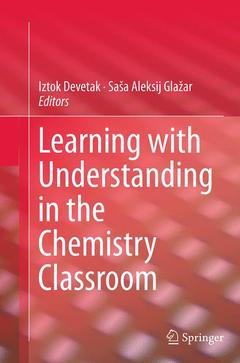Description
Learning with Understanding in the Chemistry Classroom, Softcover reprint of the original 1st ed. 2014
Coordinators: Devetak Iztok, Glažar Saša Aleksij
Language: English
Subjects for Learning with Understanding in the Chemistry Classroom:
Keywords
active learning; chemical concepts; chemical education; chemie im kontext; chemistry education; chemistry students; chemistry teachers; conceptual learning; context in learning chemistry; cooperative learning in chemistry; learning chemical concepts; learning chemistry; predict-observe-explain instructional strategy; science education; teaching chemistry; learning and instruction
Publication date: 09-2016
Support: Print on demand
Publication date: 01-2014
418 p. · 15.5x23.5 cm · Paperback
Description
/li>Contents
/li>Comment
/li>
This volume offers a critical examination of a variety of conceptual approaches to teaching and learning chemistry in the school classroom. Presenting up-to-date research and theory and featuring contributions by respected academics on several continents, it explores ways of making knowledge meaningful and relevant to students as well as strategies for effectively communicating the core concepts essential for developing a robust understanding of the subject.
Structured in three sections, the contents deal first with teaching and learning chemistry, discussing general issues and pedagogical strategies using macro, sub-micro and symbolic representations of chemical concepts. Researchers also describe new and productive teaching strategies. The second section examines specific approaches that foster learning with understanding, focusing on techniques such as cooperative learning, presentations, laboratory activities, multimedia simulations and role-playing in forensic chemistry classes. The final part of the book details learner-centered active chemistry learning methods, active computer-aided learning and trainee chemistry teachers` use of student-centered learning during their pre-service education. Comprehensive and highly relevant, this new publication makes a significant contribution to the continuing task of making chemistry classes engaging and effective.
Shows importance of active learning for the successful teaching and learning of chemistry
Suggests teaching approaches developed based on research data
Covers all levels of chemistry education from elementary school to university
Includes supplementary material: sn.pub/extras



